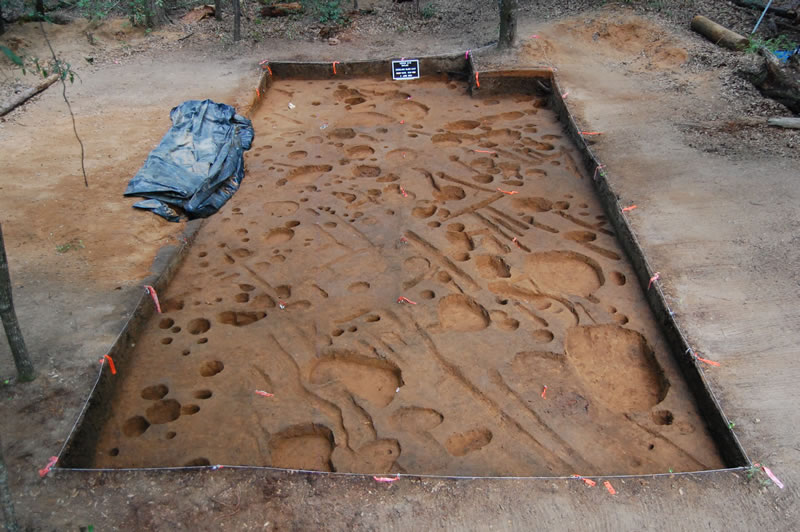
Editor’s Note: Excavations after the original 2006 publication of the Encyclopedia at the Topper site (above) revealed the possible presence of humans some 50,000 years ago in Allendale County.
S.C. Encyclopedia | Sometime during the last Ice Age human groups made their way to what became South Carolina. Current debate about the continent of origin of these immigrants suggests Asia, Africa, and Europe. Recent evidence, although scant, has suggested the possibility of humans in South Carolina as early as 18,000 years ago, but a time frame beginning by about 13,000 years ago is widely accepted by archaeologists.
At that time the climate of South Carolina was similar to that of upstate New York today. With well-fashioned, stone-tipped spears, the people, dubbed Paleo-Indians, hunted now-extinct animals such as woolly mammoths, giant sloths, mastodons, giant land tortoises, and saber-toothed tigers as well as elk, deer, and other smaller game. Preservation of the skeletons of these extinct animals in association with artifacts has yet to be discovered in South Carolina, and contexts for such preservation may be limited to Carolina bays or the bottom of the ocean. One rib bone discovered out of context on Edisto Island exhibits what appear to be intentional cut marks. Due to acidic soils, moist climate, and the ravages of time, stone tools are the only artifacts from this time, and interpretations are largely related to the manufacture, use, and discard behavior of such tools.
Only a handful of Paleo-Indian spear points have been excavated from in situ (undisturbed) deposits by professional archaeologists in Allendale, Aiken, Darlington, and Lexington Counties. Lancelet shaped, fluted and unfluted spearheads similar to ones found across the United States have been found mostly by the public and have been recorded by the archaeologist Tommy Charles of the University of South Carolina. The spear points are found in a variety of locations, but places where large streams entered major rivers appear to have been favored by Paleo-Indians.
These spear points have been made of a variety of local and nonlocal stone materials such as chert, quartz, rhyolite, and sandstone. Other common Paleo-Indian stone tools include scrapers, knives, and bola stones. Toward the end of the Paleo-Indian period during the Dalton phase, chipped stone axes appear to suggest large woodworking activities. The lack of preservation of organic items such as bone, wood, leather, cordage, and food remains hinders an exact interpretation of lifeways. Highly mobile, kin-based groups of hunter/gatherers foraging along the margins of large rivers are theorized.
At the end of the Ice Age about ten thousand years ago, climatic, faunal, and landscape changes affected societies, as evidenced by significant changes in weaponry. The period between ten thousand and eight thousand years ago is known as the Early Archaic period. During this time, the fluted point gave way to side-notched and corner-notched forms, and a spear-throwing device known as the atlatl was introduced to facilitate hunting smaller, faster game such as white-tailed deer.
A seasonal movement strategy along the state’s major river systems is hypothesized from excavations along the Savannah River. This scheme began at the coast in spring to take advantage of earlier plant growth as well as trips made to stone quarries in the lower coastal plain to replenish tool kits, followed by summer in the upper coastal plain. Groups spent fall in the Piedmont, taking advantage of mast foods (nuts), persimmons, and deer and bear that reached maximum weight due to persimmon and mast-food consumption. Mast foods may have been gathered and stored in anticipation of winter shortages and larger group sizes. Winter was spent at the fall line, the divide between the coastal plain and the Piedmont, aggregating with similar groups to increase the size of the gene pool for potential mates, schedule movements, and hold ceremonies. Positioning settlement on the fall line during winter allowed exploitation of resources in coastal plain and Piedmont habitats at times of limited or marginal resource availability.
— Excerpted from an entry by Christopher Judge. This entry hasn’t been updated since 2006. To read more about this or 2,000 other entries about South Carolina, check out The South Carolina Encyclopedia, published in 2006 by USC Press. (Information used by permission.)



 We Can Do Better, South Carolina!
We Can Do Better, South Carolina!
























